Hands-on Activities
for Teaching English
Students learn in a variety of ways. Teaching English with hands-on activities can help language students learn and practice new vocabulary, grammar, ideas, and concepts.
Click Here for Step-by-Step Rules, Stories and Exercises to Practice All English Tenses
Students learn in a variety of ways, so it is important to teach using multiple methods. Teachers should teach in a variety of ways to meet the needs of all English language learners.
Hands-on activities get your students moving and engaged in learning. Incorporating them into your lesson plans is key to reaching a variety of students.
Here are some simple ways you can get students moving and learning in the English classroom. These activities can also be used by parents, tutors, and home-school teachers.
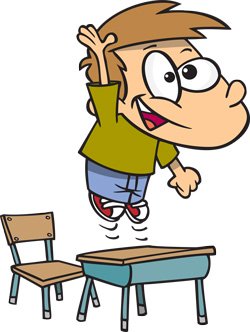
Drawing instructions
Drawing is a simple way to help students be active learners. When
teaching prepositions, shapes, and directions, instruct your students
to draw your instructions. Include prepositions and vocabulary words in
your instructions. For example, you might instruct students to draw a scene on their paper. Do not tell students what scene they are drawing. Give each instruction one piece at a time.
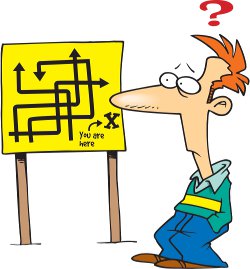
- Draw a large square on the top half of
your paper.
- Draw a large triangle on the bottom
half of your paper.
- Draw a small circle inside the
triangle.
- Draw a rectangle on top of the circle.
- Draw a star inside the square on the right half.
When you are finished, show the students your drawing and compare. Your
instructions can be more simplified or more detailed to fit the ability
of your students. You can draw a specific scene or just various
objects. You can also include colors if you want to practice color
vocabulary. This activity can be easily modified to practice lots of
English vocabulary.
Prepositions of place illustrated
You can refer to this illustration:
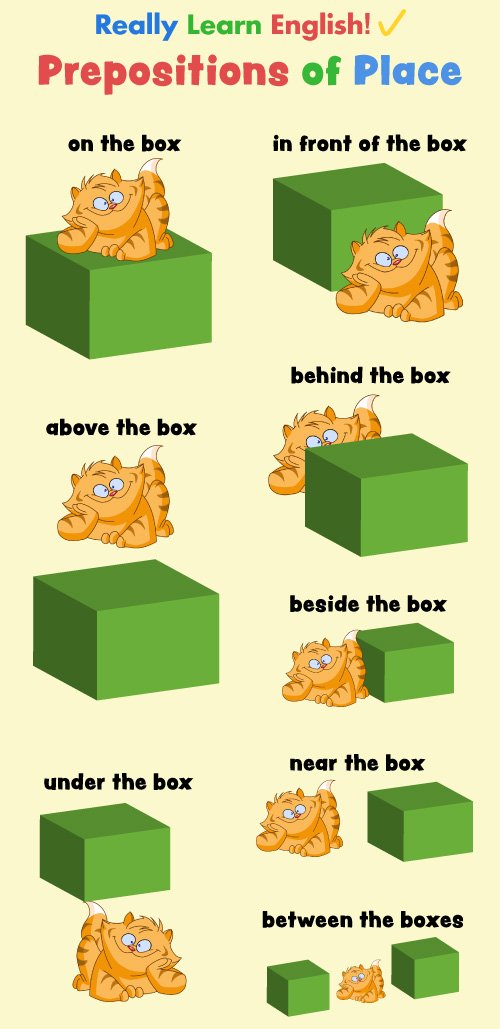
Activity examples
Example A:
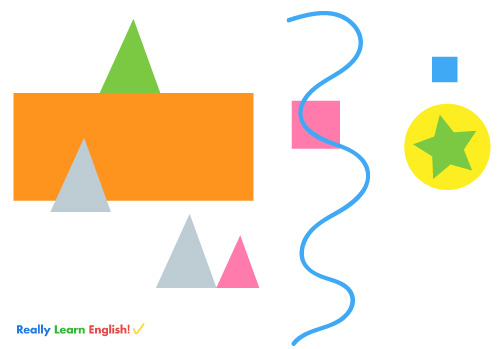
- On the left half of your paper, draw a large rectangle.
- On the rectangle, draw a triangle.
- In front of the rectangle, draw a triangle.
- Under the rectangle, draw a triangle.
- Next to that triangle draw a smaller triangle.
- Near the rectangle, draw a circle.
- In the middle of the circle, draw a star.
- Above the circle, draw a small square.
- Between the rectangle and the circle, draw a wave.
- Behind the wave, draw a medium size square.
What did you get?
Example B:
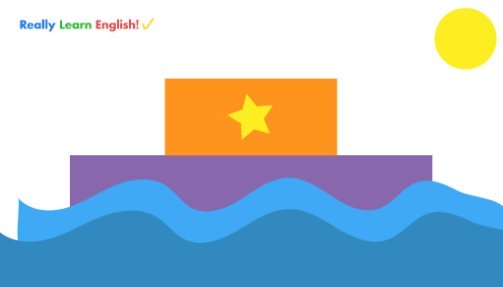
- On the bottom half of your paper, draw a large rectangle.
- On top of it, centered and touching, draw a medium size rectangle.
- In the middle of it, draw a medium size star.
- Above the medium size rectangle and next to the large rectangle, draw a circle.
- Under the large rectangle, draw a few waves.
- Above these waves, draw a few more waves.
What did you get?
In another version of this activity, put students in pairs. Have one
person in each pair draw a picture (They cannot show their partner.).
Then, partners sit back-to-back. The student who drew the picture then
gives instructions to their partner. When finished, they compare
pictures. Then switch. Give each student a chance to describe and draw.
Four corners
Four corners is a simple game that can
be used in any classroom with all ability levels. All you need is a
room with four corners. Assign each corner of your room a particular
answer focusing on specific vocabulary. For example, each corner could
be a color, direction, preposition, etc. The possibilities are endless!
The corners will remain the same answer throughout the game.
All students begin in the middle of the room. The teacher calls out a
prompt or a question, and students move to a specific corner to finish
the prompt or answer the question. Once students have picked a corner,
give them time to discuss their choice.
Example A:
Four corners:
- Red
- Yellow
- Blue
- Purple
-
The pencil is _____.
-
The book is _____.
- My shirt is _____.
Example B:
Four corners:
- Morning
- Midday
- Afternoon
- Evening
-
What is your favorite time to study?
- When do you eat lunch?
-
When do you go to bed?
-
When do you wake up?
-
When do you come to school?
- When do you leave school?
In Example B, there isn’t always a right or wrong answer. Students can discuss their answers and explain why they chose a specific answer. This is also a fun icebreaker because students can get to know each other better. Have them introduce themselves in each corner.

Corner variations: (Feel free to eliminate or add corners as needed.)
- Strongly Agree
- Agree
- Disagree
- Strongly Disagree
- Square
- Circle
- Triangle
- Rectangle
- Yes
- No
- Maybe
- To
- Too
- Two
Simon says
This is another easy game that
requires no preparation. You can modify the game to work with a variety
of vocabulary words such as body parts, propositions, and actions.
Have all your students stand. You will give instructions that they must
try to follow. If you say, "Simon says..." before the instruction, then
they should do the action. If you do not say, "Simon says…" then they
do not follow the instruction. Any student who performs the wrong
action or performs when you do not say "Simon says…" is out. The last
person standing is the winner.
Here are some examples to practice body parts:

- Simon says, "Touch your toes."
(Students should touch their toes.)
- Simon stays, "Touch your knees."
(Students should touch their knees.)
- Touch your nose. (Students should not
touch their noses. If they do, they are out.)
- Simon says, "Touch your ears." (Students should touch their ears.)
Here are some examples to practice prepositions:
- Simon says, "Stand on your chair."
(Students should stand on their chairs.)
- Simon says, "Stand behind your chair."
(Students should stand behind their chairs.)
- Stand beside your chair. (Students
should not move. If they do, they are out.)
- Simon says, "Put your foot under your
chair." (Students should put their foot under their chairs.)
Who am I?
This game is great for practicing questions and answers and descriptive words. It requires a little preparation.
Before class, write character names, occupations, or animals on note cards. To play the game, have one student select a note card. Without looking, the student must hold the note card on their forehead, so only the class can see the note card.
The student must ask questions about their card and the other
students give answers. The student tries to guess what is on the card.
Example card lists
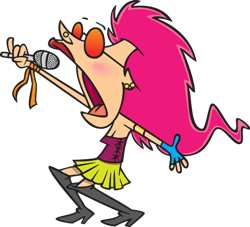 Occupations:
Occupations:
- Doctor
- Lawyer
- Teacher
- Bus driver
- Police officer
- Nurse
- Construction worker
- Singer
- Chef
- Pilot
 Animals:
Animals:
- Bird
- Bear
- Dog
- Cat
- Horse
- Cow
- Goat
- Chicken
- Monkey
 Family members:
Family members:
- Mom
- Dad
- Brother
- Sister
- Uncle
- Aunt
- Grandma
- Grandpa
Other list ideas:
- Characters from popular movies / television shows
- Characters from a class novel
- Students in class
Sentence cards
Write sentences on note cards, putting one word on each card. The last word should also include the ending punctuation mark. Put students in groups. Give each student a card or two. Instruct students to form one sentence by putting their cards in order. Then have the students read their sentence to the rest of the class.You can practice specific types of sentences with this activity:
For a variation of this activity, give students a variety of words (two or more cards per student), and allow them to make one or two sentences out of the words. After presenting their sentences, instruct them to make new sentences with new words or team members.

Matching cards
In this activity, students are given cards and they must match their card with one or more students. This activity takes a little preparation.
Before class, create sets of note cards based on the vocabulary you want to study. For example, if you are studying animal words, you could put a picture of an animal on one card and the word on another card. Or, you could use irregular verb forms such as break, broke, and broken.
Here are some other list ideas:
- Vocabulary words and definitions
- Vocabulary words and pictures
- Verb tenses
- Verb forms
- Adjective forms
- Adverb forms
- Questions and answers
- Antonyms
- Synonyms
- Compare and contrast
- Causes and effects
Additional resources for teachers:
More Hands-on Activities and Games for Teaching English
How to Teach English – Advice and Many Resources
Activities for Teaching Vocabulary: How Can You Teach (or Learn) New Words?
Get Updates, Special Offers, and English Resources
Download your FREE GIFT (the first two chapters of
English Short Stories Book and Workbook)
as soon as you join!

By submitting your email, you consent to receiving updates and newsletters from us and to the sharing of your personal data with third parties for the purposes of sending you communications. We will not spam you. You can unsubscribe at any time. For more information, please see our privacy policy.
Return
from Hands-on Activities for Teaching English to
How to Teach English





